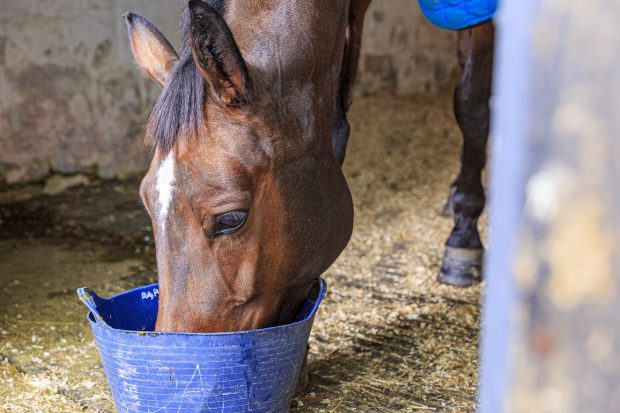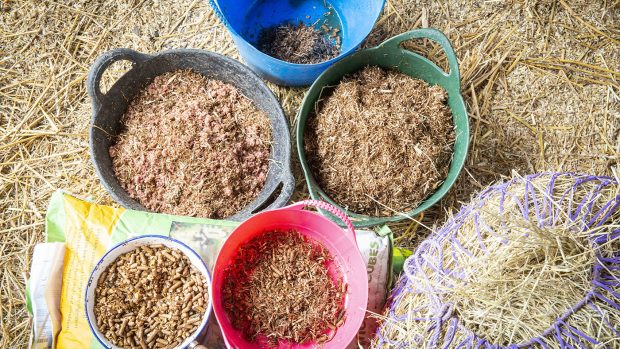As the chilly north wind starts to bite around the country, owners are likely to be reviewing their horses’ diet to ensure they maintain condition during the next few months.
Signs of poor condition
Owners should be on the look out for the following signs throughout the winter:
- Ribby appearance
- Loss of condition around the hips and withers
- Dull rough coat
- Failure to gain weight
- Loss of weight and/or stamina
- Poor growth rate in young horses
Horses exhibiting these signs should be checked for non-nutritionary factors, which might be contributing to their weight loss, and their management adjusted accordingly before any change to their feeding regime is made.
Problems that can affect a horse’s condition include:
- Worms
- Poor teeth
- Low-grade pain such as arthritis (especially older horses)
- Windsuckers and crib biters
- Prolonged levels of hard work
- Nervous or young horses distracted by noisy or unusual surroundings
- Colts and fillies kept adjacent to each other
- Horses kept on their own, who may fret and become picky eaters
- An illness such as colic, surgical operations or virus
Feeding for condition
Hay should provide at least 50% of a competition horse’s diet throughout the year and up to 90% of a leisure horse’s diet. When a feedstuff is providing this level of nutrients, it is important that you have an idea of its energy and protein content, so that you can adjust hard feed intake accordingly. This can be achieved by having your hay analysed.
Many hays provide enough energy for maintenance and light work, however, data obtained from the Dodson & Horrell analytical laboratory shows that hays can vary considerably in energy content and most hays are deficient in quality protein, vitamins and minerals.
On average hay contains between 33 and 50% of the horse’s required levels of vitamin A, 25% of the vitamin D needed and as little as 5% of the recommended levels of vitamin E.
Vitamins A and E are essential antioxidants, which are important for the body to support the immune system and to mop up free radicals. Free radicals are produced as a result of normal metabolism but are thought to increase in times of stress.
Grass and other plants would normally provide a natural source of these antioxidants. Recent research supported by Dodson & Horrell has shown that many horses have low levels of antioxidants in their blood, and that feeding a supplement containing both plant-based antioxidants and vitamins and minerals can increase antioxidants levels. As a result the company now includes this supplement (QLC) in all its feeds.
Safe weight gain
The quality and quantity of forage and hard feed being fed needs to be checked and the diet adjusted to ensure a slow steady weight gain. Initial weight gain should be based on small frequent meals, rather than a couple of large feeds per day. Grazing should be built up slowly and forage should form the greatest part of the diet.
Feeds which are highly digestible, contain adequate vitamins and minerals and antioxidants, with good quality protein and slow releasing energy sources (predominantly oil and fibre) are most successful in improving condition, without causing horses to become unmanageable.
Condition should be monitored weekly preferably by using a weightape, or by condition scoring. Once the horse has reached its desired weight, feed levels will need to be adjusted to maintain condition levels.
Dodson & Horrell recommends . . .
Alfalfa Chaff, Fiber Blend and Fibergy are sources of quality protein, calcium, natural minerals and slow-releasing energy from fibre. High quality fibre should always provide the basis for any sound feeding programme.
Build-Up and Build-Up Cubes are high in slow-releasing energy sources, fibre and oil to promote condition while minimising the risk of excitability. Both feeds contain quality protein to encourage muscle and top-line development in response to exercise, plus Yea-Sacc to promote healthy hind-gut digestion and QLC to support the horse’s natural systems.
During October 2003, 10,000 bags of Dodson & Horrell Build-Up Cubes will contain an extra 10% free. Special promotional bags will contain 22kgs for the price of 20kgs so look out for them at your feed merchants.
Other feeds to consider if your horse is losing weight include:
- Sixteen Plus: for the old horse
- Yearling Cubes: for the growing youngster
- Soya Oil: a concentrated energy source
Dodson & Horrell has produced a fact sheet “Feeding with Condition in Mind’” which provides helpful tips on keeping condition on your horse this winter. For your copy of the leaflet and a sample of Build-Up or Build-Up Cubes e-mail: enquiries@dodsonandhorrell.com or call the Dodson & Horrell helpline (tel: 0870 442 3322).




